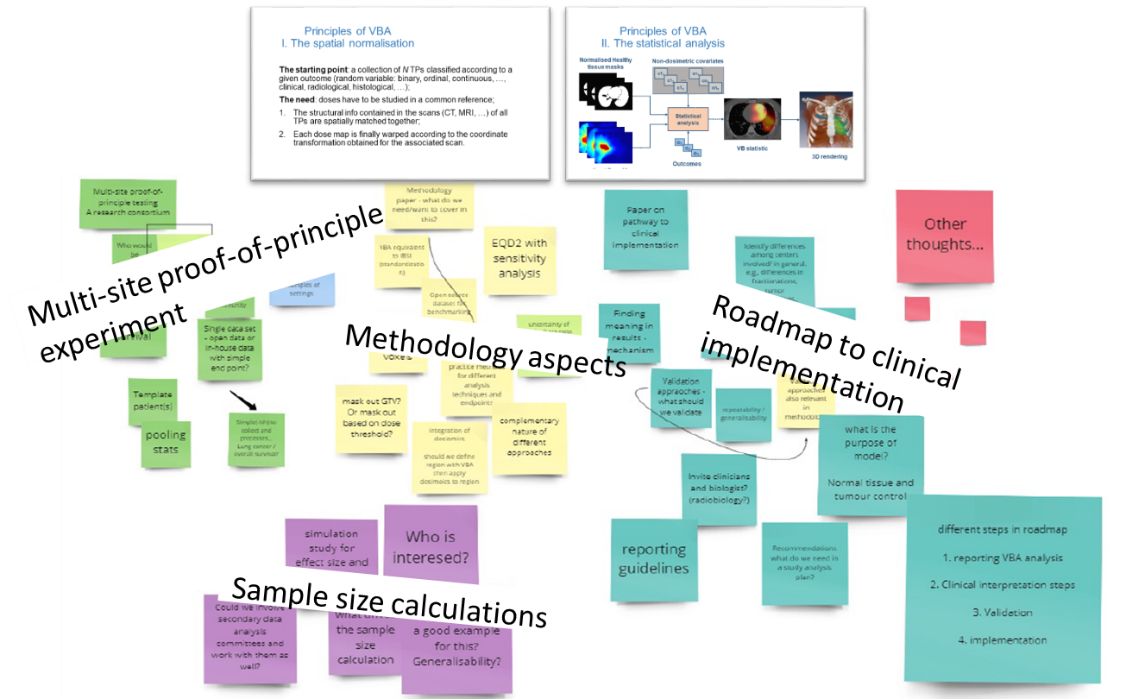The conformality rush of the last decade has revealed the existence of radiobiological phenomena that were either concealed or ignored in the classical radiation therapy (RT) treatment strategy. On the one hand, the progressive sparing of healthy tissue permits a focus on toxicity outcomes that was impossible using historic RT delivery techniques. On the other hand, the increasing heterogeneity of dose distribution across organs-at-risks (OARs) highlights the existence of dose-response patterns and, as a result, emphasises the limits of the traditional dose-volume histogram (DVH)-based toxicity analysis and toxicity modeling philosophy. The high sparing capability of modern techniques at the same time demands for more and more accurate insights of possible avoidance region within a specific OAR for an effective plan optimisation.
In recent years, a new methodology is emerging where the spatial information of the planned dose for every patient is maintained. No assumptions are made regarding anatomical regions, instead the dose in every voxel across many patients is analysed against a given outcome including survival or radiation-induced morbidity. This process identifies sub-regions within an anatomical location that are most strongly correlated against these outcomes and, therefore, can better define the anatomy driving these outcomes.
This new approach for dose distribution analysis, commonly referred to as voxel-based analysis (VBA), consists of two main processes: spatial normalisation of the different anatomies in the analysed cohort of patients to a common reference and statistical inference on the spatial signature of dose response (Palma et al EJMP 2020).
So far VBA has been successfully applied by a small number of research groups to several tumor types and to different toxicity endpoints (Acosta et al Phys. Med. Biol 2013, Palma et al, IJROBP 2016, Monti et al Sci Rep 2017, Beasley et al IJROBP 2018) or mortality (McWilliam et al EJC 2017, Green et al Frontiers Oncology, 2021) and to identify anatomical regions driving biochemical recurrence (Witte et al IJROBP 2010).
Now, to fully empower such technique, we need robust image normalization approaches as well as statistical analysis. In addition, a crucial issue is the possibility to mine dose distributions across multiple institutions. This would ensure a wider heterogeneity of patient populations and treatment techniques, more robust and generalisable results, and opportunities for validation. Combining datasets can be achieved by pooling data in one location or via distributed learning networks.
Given this scenario, the aim of our workshop (WS) was discussing the key aspects of VBA in RT to lay the basis for a common framework in which the methodology could be developed. The online WS was organized over two-days, during which invited speakers addressed the current methodologies adopted for VBA studies. These focused on, 1) different aspects of spatial normalization (O. Acosta, France) and 2) statistical analysis (M. Witte, Nederland). Afterwards, the participants were invited to present their research activities and their expectations in attending the WS. As chairs, we were happy to have active participants involved in the discussions from across Europe – including Sweden, Germany, UK and Italy – and Australia. All participants were free to express their comments and proposals, and, based on participant feedback and discussion (Figure), we were able to define potential outputs that will form the follow-on work and that can be summarized as follow:
1) The creation of a Research Consortium in order to perform the first multi-site VBA experiment via a distributed learning approach. We defined the first principal – but not all – characteristics for this proof-of-principle experiment that should define the pathway to larger studies and research questions, such as registration template choice and evaluation of spatial normalization.
2) A workgroup for consensus requirements that VBA should fulfil so as to be implemented into the clinics, taking into account the emerging exemplars on which some groups are currently working.

The brainstorming and planning phase completed during the WS has been then channeled in a rich agenda of follow-up meetings for mapping future work and actionable tasks.
In conclusion, we believe that by this WS on mining the RT dose we fulfilled our initial purpose, that is to say to lay the foundation of a VBA community within the ESTRO in order to open new pathways to a common and standardized VBA methodology, thus ensuring its future clinical validation and safe large-scale adoption.